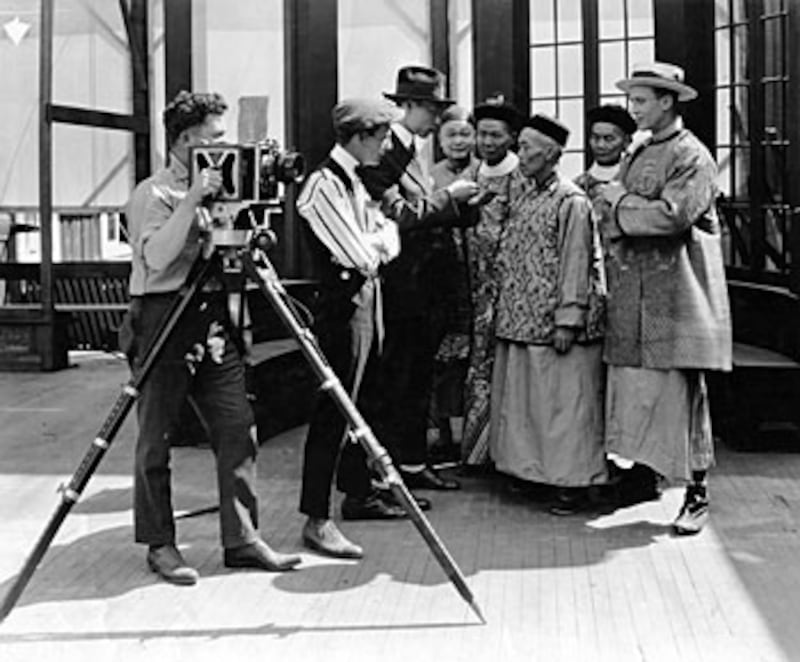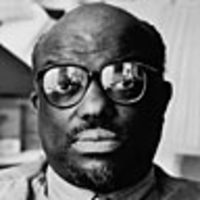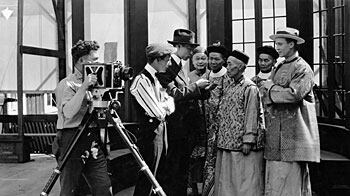
At the opening of Hollywood Chinese, which premiered this week on PBS, film historian Stephen Gong states the thesis of an entertaining and somewhat informative documentary that, given its chosen constraints, is a good start.
“Films are about image-making,” Gong says, “and, at our peril sometimes, we misread and we mistake the images we put up for realities that we create. This is not small term. It’s entertainment industry on one hand, but it’s the way that our hopes and our aspirations and our expectations of one another are played out on that screen.”
Important historical, cultural, and aesthetic facts are either melted down or lost in a production that seems hemmed in and only about half as good as it could be.
That is only partially true. The other part has a consistency that the documentary alludes to often but does not live up to with thorough thinking and deeply provocative but accurate judgments. The blue steel fact is that part of the eventual freedom afforded any minority or immigrant population in America is to see its image take a place on the automated assembly line of the caricature and begin its very own journey through the dehumanizing head and body mask imposed by the menacing or buffoonish cartoon. At an unpredictable pace, that vulgar drawing becomes a stereotype—perhaps even a stock character. The image is finally lifted beyond its iron mask through what we might call the inevitable national alchemy. We do not know when, but we should know that every group is destined to be seen as human in American terms and that it will help define how fundamental but elastic those terms actually are as they contribute to our natural history.
This process leads ethnic groups beyond cardboard exotica and into the mysterious world of contractions and disappointments distinguished by inspirations that we understand as the condition of full humanity. As ease muscles itself into that arena, middle-class life becomes the salvation and the state of mind or class in which the adventures, the romance, and the joy brought by defeating great trouble do not obtain. The supposed heaven of dullness is soon met with rebellion as predictable as things were at the very beginning. That’s American life for you!
For Asians, the first stage of that evolution came in the form of yellowface, a term used to describe another obligatory version of blackface. At its worst, yellowface was exclusively demeaning and a perversion of the universal love of masking, which allows performers to express themselves, or their artistry, in the guise of someone else. At its best, as in 1937’s The Good Earth, we see the latter version of yellowface, where artistic levels of film are sought in the vocabulary of the time and white audiences were introduced to Asian humanity in an epic frame. There were other stations of the aesthetic cross along the way, but they were largely detective tales, war movies, and small parts as coolies of one sort or another.
The Chinese did not again achieve identification in epic terms until Amy Tan’s The Joy Luck Club was skillfully transformed into a shooting script and released in 1993. What happened until 1937 and why it took almost 60 years to extend upon the groundwork laid by The Good Earth is an intriguing piece of Americana that Hollywood Chinese succeeds at telling more through its well-chosen and well-edited talking heads than through any overall conception of cultural clarity.
Important historical, cultural, and aesthetic facts are either melted down or lost in a production that seems hemmed in and only about half as good as it could be. The show settles for telling us a very old story of ethnic exclusion that should not be forgotten. But those facts alone do not make this tale of bigotry and its consequences especially new. Missing is the bite a few deeper thoughts would have provided.
When the well-known Asian actor James Hong says of the narrow cinematic depictions of Asians, “The writers didn’t know how to write another role for the person who was an average citizen who was Asian American,” he is clearly correct. But the real question is why Asians came to America in the first place if they were not just seeking the money that they could send home to their families.
Joan Chen hits that one into the bleachers. Chen first lit her star in the firmament in 1987’s The Last Emperor, and she gives us some human understanding of the American attraction to those with supposedly yellow skin. Born in 1961, Chen grew up during the remarkably soulless Cultural Revolution and was singled out at 14 for her marksmanship by Mao’s wife. She speaks of how moved she was by the very sentimentality in the love story Waterloo Bridge starring Vivien Leigh and Robert Taylor. After pointing out how effectively Leigh used her eyes, Chen says: “It was wonderful because we were living in a world without any sentimentality. Without any personal love stories. You know, you are not allowed. So to me that was just beautiful. That was my notion of Hollywood.”
There it is. Freedom was as much an attraction to the Chinese as it was to any other immigrant group. This is implied but it never fully stated because the show seems somewhat tainted by the identity politics in which uncritical love of national origin is an imperative. So, in certain ways, Hollywood Chinese founders into another stereotype of the Chinese by being far too polite.
The most surprising break the Chinese got in early mass media came from arch bigot and cinematic innovator D.W. Griffith, who had used celluloid to justify and celebrate containment of black Americans in Birth of a Nation, a mix of genius as pure as its grating and hysterically racist superstitions.
Griffith’s 1919 Broken Blossoms was another first. It came from the other end of the field, depicting the refinement, spirituality, and love of beauty had by a Chinese man as a rejoinder to brawling and drunken London louts. As important a moment in American film history as that was, even within the conventions of yellowface, it is not examined by Hollywood Chinese. This may well be due to the fact that choosing to discuss Griffith takes one into the duplicity of many elements of image-making in our culture.
What is lost in deeper and sharper thinking is made up for in the documentary by the lack of conventional bitterness common to ethnic posturing. That delusion never really applied to Asians, who were always closer to the acknowledged conventions of easily swallowed behavior—even functioning under an exotic and genetic paint job—because they were considered capable of intelligence, even brilliance. Not a small thing. While Charlie Chan was proving himself the smartest man in the room and audiences were lining up around the block to see The Good Earth, Bill Robinson was playing a white-haired giggle box there to teach Shirley Temple to tap dance up a flight of stairs. Not the same thing.
The screen detective’s brilliance is why Charlie Chan was quite popular among the Chinese, and Keye Luke as “Number One Son” was such an all-American character. As Hollywood Chinese shows, Chan’s son was the cinematic emblem of the Asian college graduate who moved back and forth between the so-called white world and the Chinese-American sector. As a member of the U.S. Olympic team who was cheered by the white folks, “Number One Son” was most interesting because he, like those all-American characters who can speak flawless English as well as the mother tongue of their ethnic group, is not beset by any identity problem, because dual understanding was not yet seen as a confused state.
Actor after actor recalls the sensation of being transported by film at an early age or expresses appreciation of the acting skill and the seriousness of Luise Rainer’s yellowface performance in The Good Earth. This is especially moving in the inclusive humanity of Lisa Lu, who knows the difference between a demeaning version of yellowface or the dumb roles assigned to Asian actors, and what she details about Rainer’s performance, which touched her with both its artistry and its accuracy.
The very responsible way the documentary handles certain things is made clear in the freedom that led its makers to allow Rainer—who is almost 100 years old—not defend yellowface but to make a plea for one of the signal functions of the actor: to find the universal qualities that transcend surface distinctions. They are what brings audiences to identify, in ways truer than the obvious and the superficial, the central curses of our moment when cartoons dominate as they are delivered with high technology and virtuoso editing.
A purely American kind of unintentional comedy is also revealed in the liberty to be ridiculous that white actors were given because so few in the national audience questioned things in the way they do now. Turhan Bey observes at one point that each member of a Chinese family could have a Russian accent, a continental European accent, a New England accent, a Jewish American accent, and an accent from the American West, which is now hilariously surreal but was not even questioned in the ’40s!
As a talking head, Tan, author of The Joy Luck Club, brings pure intelligence, mature reason, and a recognition that the country is now no longer only open to stories about immigrants from Europe. The American appetite for human stories has never been bigger, which is one of the reasons why the film began a crossroad in the national cinema by opening up a new direction as thoroughly mapped out by tradition as it was an expansion of it.
Something of a vastly more complicated A Letter to Three Wives, its interwoven stories take the women’s picture into new areas. The flashbacks reveal how the Asian middle-class serenity in San Francisco was achieved by mothers who had been able to reverse the Chinese belief that daughters were of secondary importance by not simply but firmly stepping up and metaphorically traversing hot stones in their bare feet. The daughters seem as Jewish as Asian, perhaps because Jewish Americans seem to have most thoroughly defined the terms of middle-class discontent and the need certain children have for overt affirmation from their parents.
Unfortunately, John Lone, one of the greatest actors to appear on screen in the last two decades, is not acknowledged for his work in The Last Emperor or his phenomenal performance as Joey That in Year of the Dragon. The cool originality Lone delivers is so far from any kind of cliché that its masterfully nuanced freshness is only challenged by Don Cheadle as the cold but hot-headed Mouse of Devil in a Blue Dress. All that needs to be said about the poverty of roles available for Asian actors can be expressed in four words: What about John Lone?
There are some dumb things said about kung fu films, and one would think they are all as characteristically imaginative and visually inventive as Crouching Tiger, Hidden Dragon or Hero. Martial-arts Westerns for the most part, they are as boring as most Westerns because the formula is not an invincible substitute for artistry. Fortunately, questions are raised about insecure masculinity, leading certain Asians like young filmmaker Justin Lin to say: “A lot of kung fu films are from Asia, so the characters are actually are more empowered. They feel comfortable. They are in their environment. As an Asian American, you are actually kind of attached to that. You are kind proud of it because they kick ass.”
Lin made a name for himself with Better Luck Tomorrow, which sounds like a Hong Kong shoot-’em-up but is actually about something far more interesting and seems to fulfill the cycle of motion from racial exclusion to bourgeois disenchantment. Model minority Asian kids gulp down the spiritually poisonous Kool-Aid of trying to be badasses as a way of escaping middle-class expectations. One reviewer observed that Lin showed his artistry when his protagonists find themselves trembling in the face of real Asian thugs just after crowing over scaring the dog dookey out of some white boys. The “play-play” ethnic gangster is but another variation on the supposed tough guy being exposed as a cream puff. As Ishmael Reed once pointed out in conversation, “Any genre or theme can be freshened up with an ethnic point of view.”
Accomplished Chinese director Ang Lee sums the whole business up best when he says at the conclusion of Hollywood Chinese: “There is complexity in life. Things overlap, they are mixed up, they have complexities. And I hope in the future people just identity with individuals, individual filmmakers, cases, stories, way of filmmaking, and just see as is and respect that.”
Somebody got it right, because all art, entertainment, exploitation, and masking exist for no more than what Ornette Coleman calls “the human reason.” As long as we realize that, we may not get to the golden mean when we would like, but perhaps others will.
Stanley Crouch's culture pieces have appeared in Harper's, The New York Times, Vogue, Downbeat, The New Yorker, and more. He has served as artistic consultant for jazz programming at Lincoln Center since 1987, and is a founder Jazz at Lincoln Center. In June 2006 his first major collection of jazz criticism, Considering Genius: Jazz Writings, was published. He is presently completing a book about the Barack Obama presidential campaign.





